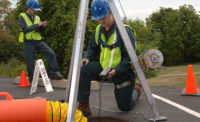OSHA has started the process for a potential Noise in Construction standard. Two recent studies on occupational hearing loss conducted by the Department of Energy and NIOSH found that a significant percentage of construction workers have suffered hearing loss over the duration of their careers.
Every year, approximately 30 million people in the United States are occupationally exposed to hazardous noise, OSHA says1. Noise-related hearing loss has been listed as one of the most prevalent occupational health concerns in the United States for more than 25 years. Thousands of workers every year suffer from preventable hearing loss due to high workplace noise levels. Since 2004, the Bureau of Labor Statistics (BLS) has reported that nearly 125,000 workers have suffered significant, permanent hearing loss. In 2009 alone, BLS reported more than 21,000 hearing loss cases.
Proposed standard
The potential standard was included on OSHA's regulatory agenda published in May, with the agency planning to issue a request for information in November to gauge the effectiveness and feasibility of adopting more protective noise-hazard requirements.
The agency currently has the permissible exposure limit for construction noise at 90 A-weighted decibels over an eight-hour period, but NIOSH's recommended exposure level is 85 A-weighted decibels over that timeframe.
A standard could offer construction workers protection from hearing loss already available to general industry workers via the OSHA Hearing Conservation Amendment, which specifically excludes the construction sector, stakeholders said. Current federal construction noise rules do not mandate hearing conservation programs or testing at equivalent levels required by the amendment for general industry employees.
OSHA’s spring 2016 agenda
In the spring 2016 “Unified Agenda of Regulatory and Deregulatory Actions” for federal agencies, OSHA published the following regarding the Noise in Construction standard, which would enact more protective noise hazard requirements in construction. OSHA states: “Two recent studies of occupational hearing loss conducted by Department of Energy and National Institute for Occupational Safety and Health concluded that a significant percentage of construction workers have suffered from hearing loss over the duration of their careers. It has been noted that construction work is excluded from the OSHA Hearing Conservation Amendment that is required for general industry work. Also, existing construction noise requirements lack the specificity of a general hearing conservation program that must be implemented for general industry work.”
Different rules
In June, Chris Trahan, deputy director of CPWR in Silver Spring, Maryland, told Business Insurance2 magazine that “construction workers’ ears are not any tougher than workers in factories, but the two rules are really different. It's not a great regulatory scheme we have in construction for noise. It's lacking, and people lose their hearing exposed to levels lower than 90.”
The state of Washington state has adopted a different noise standard than OSHA's because it sets the permissible exposure limit at 85 decibels over an eight-hour timeframe and requires workers exposed to levels above that during their full shift to wear hearing protection devices, Richard Gleason, a senior lecturer in the Department of Environmental and Occupational Health Sciences in the School of Public Health of the University of Washington in Seattle, told Business Insurance.
1 www.osha.gov/SLTC/noisehearingconservation
2 www.businessinsurance.com/article/20160615/NEWS08/160619892/osha-construction-noise-standard



